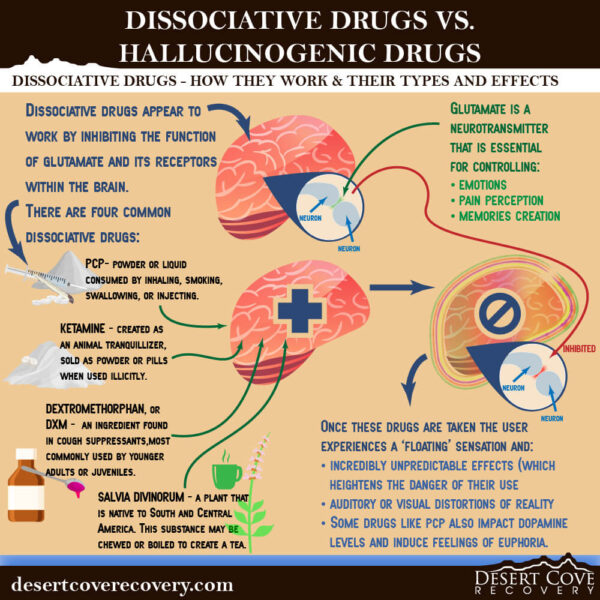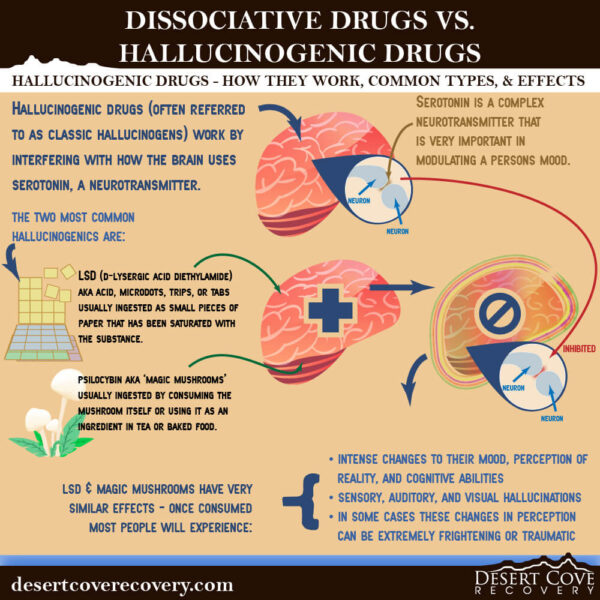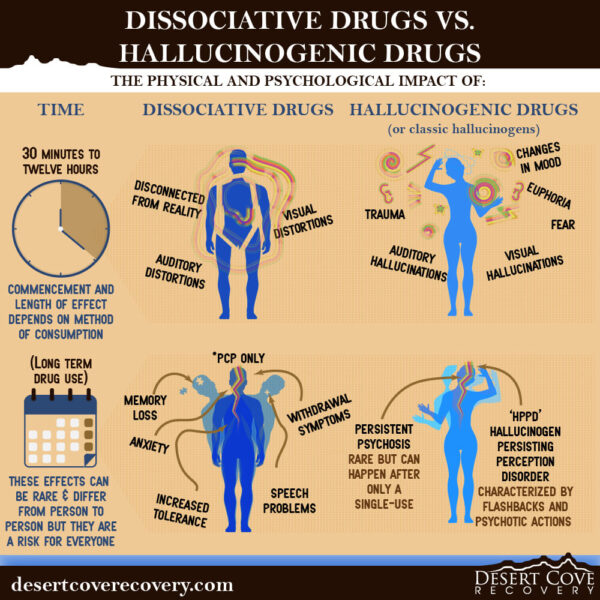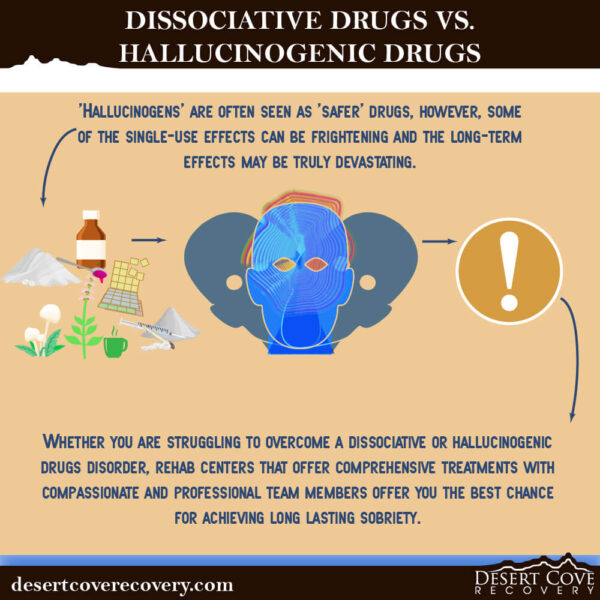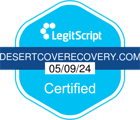“Hallucinogens” is a broad term used to describe drugs that can alter an individual’s perception of reality. This group of drugs is divided into two distinct categories: hallucinogenic drugs and dissociative drugs. The former is sometimes referred to as “classic hallucinogens.”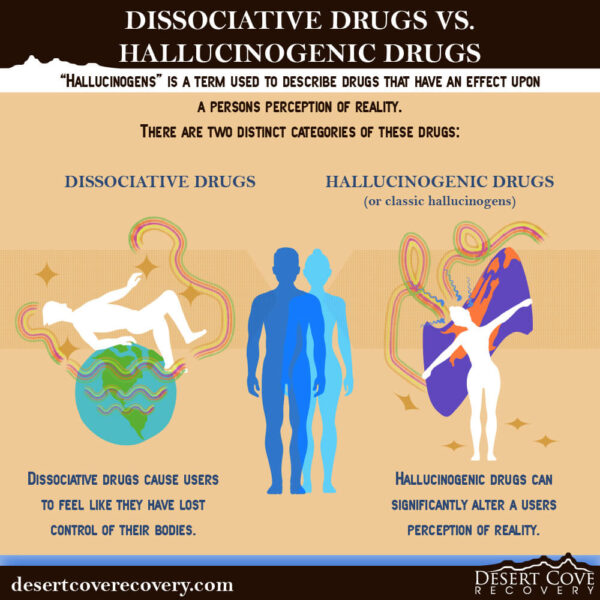
To help you better understand these two dangerous drug classes, we have outlined some essential information about each type of substance below.
What Are Dissociative Drugs?
Dissociative drugs typically cause those who use them to feel like they have lost control of their bodies. They may also experience a feeling of being disconnected from their environment. These drugs are so named because patients often report becoming “dissociated” from reality.
How Do Dissociative Drugs Work?
While the exact mechanism of dissociative drugs is not entirely understood, laboratory research suggests that these substances work by inhibiting the function of glutamate and its receptors within the brain.1
Glutamate is essential to controlling emotions, perceiving pain, and forming memories. Some dissociative drugs, such as phencyclidine (PCP), can also impact dopamine and induce feelings of euphoria.
Once consumed, dissociative drugs may make the user feel as though they are floating. These substances can also cause auditory or visual distortions of reality. The exact effects that an individual will experience are incredibly unpredictable, which magnifies the danger of abusing dissociative drugs.
Common Dissociative Substances
There are four common dissociative drugs: PCP, ketamine, dextromethorphan, and salvia divinorum.
- PCP
PCP is often obtained in either powder or liquid form. Individuals with a substance use disorder may consume PCP by inhaling, smoking, swallowing, or injecting the chemical. It may also be combined with other drugs, such as cannabis.
- Ketamine
Commonly referred to as Special K, ketamine is intended for use as an animal tranquilizer. When used for illicit purposes, it may be sold in a powdered form and turned into pills.
- DXM
Dextromethorphan, or DXM, is an ingredient found in cough suppressants. Since DXM is available in several over-the-counter medications, it is most commonly used by younger adults or juveniles.
- Salvia
Salvia divinorum, typically referred to simply as “salvia,” is a plant that is native to South and Central America. This substance may be chewed or boiled to create a tea.
Impacts of Using Dissociative Drugs
In the short term, dissociative drugs can cause auditory and visual distortions. These distortions may last for several hours. Users typically experience an onset of symptoms within a few minutes of ingesting the dissociative substance.
According to the NIH, the long-term impacts of most dissociative drugs have not been thoroughly researched.1 However, PCP usage can cause individuals to develop a tolerance. They may also experience withdrawal symptoms, memory loss, anxiety, or speech difficulties.
What Are Hallucinogenic Drugs?
Hallucinogenic drugs can significantly alter an individual’s perception of reality. They can cause sensory, auditory, and visual hallucinations but typically do not make individuals feel detached from their bodies. These hallucinations may be frightening or traumatic.
How Do Hallucinogenic Drugs Function?
It is believed that classic hallucinogenic drugs work by interfering with how the brain uses serotonin, a neurotransmitter.1 Although each individual’s experiences will vary, most people who use hallucinogenic drugs will experience profound changes to their mood, perception of reality, and cognitive abilities.
Common Psychedelic Drugs
While many different substances have hallucinogenic properties, two of the most commonly abused are d-lysergic acid diethylamide (LSD) and psilocybin.
LSD is often referred to as acid, microdots, trips, or tabs. It is either white or clear and is water-soluble. LSD is usually found in the form of paper that has been saturated with the substance.
The most widely used slang term for psilocybin is “magic mushrooms.” This substance can be consumed by ingesting the mushroom itself. However, individuals may extract the psilocybin by brewing it into tea. Psilocybin and LSD produce very similar effects.
Effects of Hallucinogenic Drugs
In the short term, hallucinogenic drugs may cause individuals to experience auditory or visual delusions.
The onset of hallucinations will vary depending on the consumption method. For instance, LSD typically has a rapid onset of approximately 20 to 30 minutes, whereas psilocybin may take up to 90 minutes to impact the user.1 The entire experience can last up to 12 hours, depending on the dosage size and individual patient factors.
There are two potential long-term effects of using hallucinogenic drugs. Some individuals may develop persistent psychosis. While this condition is rare, some users experience this lasting effect after only a single-use.
The second long-term effect of hallucinogenic drugs is known as hallucinogen-persisting perception disorder (HPPD). This condition is characterized by flashbacks and “psychotic manifestations” that may persist even after long periods of substance abstinence.
Outpatient Treatment Services from Desert Cove Recovery
If you or a loved one are struggling to overcome a dissociative or hallucinogenic drug use disorder, Desert Cove Recovery can help. We offer comprehensive outpatient services that include holistic treatment strategies.
Contact us today to speak with one of our compassionate and professional team members. We will gladly answer any questions you may have, discuss insurance coverage, and discuss our various treatment options.
Source:
[1] https://www.ncbi.nlm.nih.gov/pmc/articles/PMC3736944/

